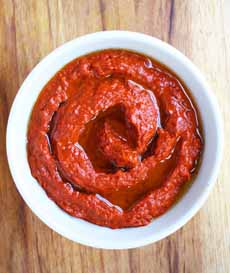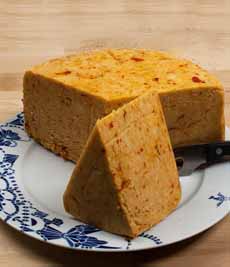TIP OF THE DAY: Harissa & How To Use It
|
|
Like hot and spicy foods? Try harissa, a North African hot paste and sauce originally from Tunisia. It contains peri peri chiles, serrano chiles, garlic, coriander, caraway, and other spices. This “unofficial condiment of Tunisia” is extremely versatile. In Tunisia, Morocco and across North Africa, harissa flavors almost all of the local cuisine: While you can purchase harissa in jars, it’s easy to make at home (see the recipe below), where you can adjust the amount of heat with the type or the number of chiles. We use smoky chiles: chipotle (dried, smoked red jalapeño) and/or the mild ancho (dried, smoked poblano). For serious smoky heat, look for smoky bhut jolokia chiles, a.k.a. ghost chiles (the different types of chiles). Harissa is meant to be hot. Beyond heat, harissa delivers a depth of flavor not provided by hot sauces, including sriracha. Don’t like a lot of heat? Make red bell pepper sauce instead, and add a pinch of heat: chile flakes or hot sauce to taste. Harissa has a place in every meal, from breakfast to dinner. You can even add a bit in a fruit salad for dessert. Seasonings vary widely, but caraway, coriander, and cumin are cornerstones. Dried chiles are a key ingredient in harissa. You can use any combination you like. Ingredients 1. REMOVE the stems and seeds from the chiles. Bring a medium pot of water to a boil, remove from the heat and add the chiles. Cover the pot and let the chiles steep until soft, about 20-30 minutes. Drain (you can reserve the water to add flavor to other dishes, from boiled potatoes to poached eggs). |
|
|
2. TOAST the spices in a dry skillet on the stove top, until fragrant. Grind them in a spice grinder or a mortar and pestle. Add to a blender or food processor along with the chiles and the remaining ingredients, and purée. You want a thick paste, but can add additional oil to achieve the desired consistency. 3. STORE in a sterile jar, for six months or longer in the fridge. Cover the surface with a thin layer of olive oil to keep the color from oxidizing. Each time you use some paste, add another layer of olive oil before returning to the fridge. |
||




